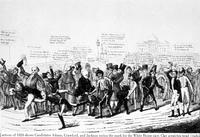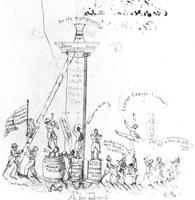1824
| Candidate |
Popular
|
Electoral
|
| John Quincy Adams Democratic-Republican |
113,122
|
84*
|
| Andrew Jackson Democratic-Republican |
151,271
|
99
|
| William H. Crawford Democratic-Republican |
40,856
|
41
|
| Henry Clay Democratic-Republican |
47,531
|
37
|
| *The election was decided by the House of Representatives since neither candidate received a majority of the electoral votes. John Quincy Adams (public domain) from the Library of Congress Prints and Photographs Division |
David Claypoole Johnston, a fine early cartoonist, holds the position as the author of the first cartoon that had as its subject a presidential campaign (10A-1066500). In this cartoon, "A Foot Race," John Q. Adams, William Crawford, and Andrew Jackson are "on the mark" to begin the race for the White House. An unruly crowd jokes in the background, and Henry Clay looks on, scratching his head. This is an example of the recurring sport or game theme found in presidential campaign cartoons.
The presidential race of 1824 was more a test of diplomacy than of speed. In this cartoon, "The Five Aspirants," an anonymous artist represents all the possible candidates and their "positions" on various issues (10B-1066501). John Quincy Adams needed all his diplomatic tact to be elected in a country split by sectionalism. New England was divided on the issue of tariffs, the shift from dominance of foreign trade to that of manufacturing not yet completed. The Middle States were pro-tariff and pro-internal improvements, the South against both, and a growing popular vote in the West opposed the South. Though Adams won the election, Andrew Jackson made a good showing in the West, where the pioneer spirit that was to dominate the political scene until the Civil War, replacing the Eastern influence which elected men like Adams, was making its voice heard.




